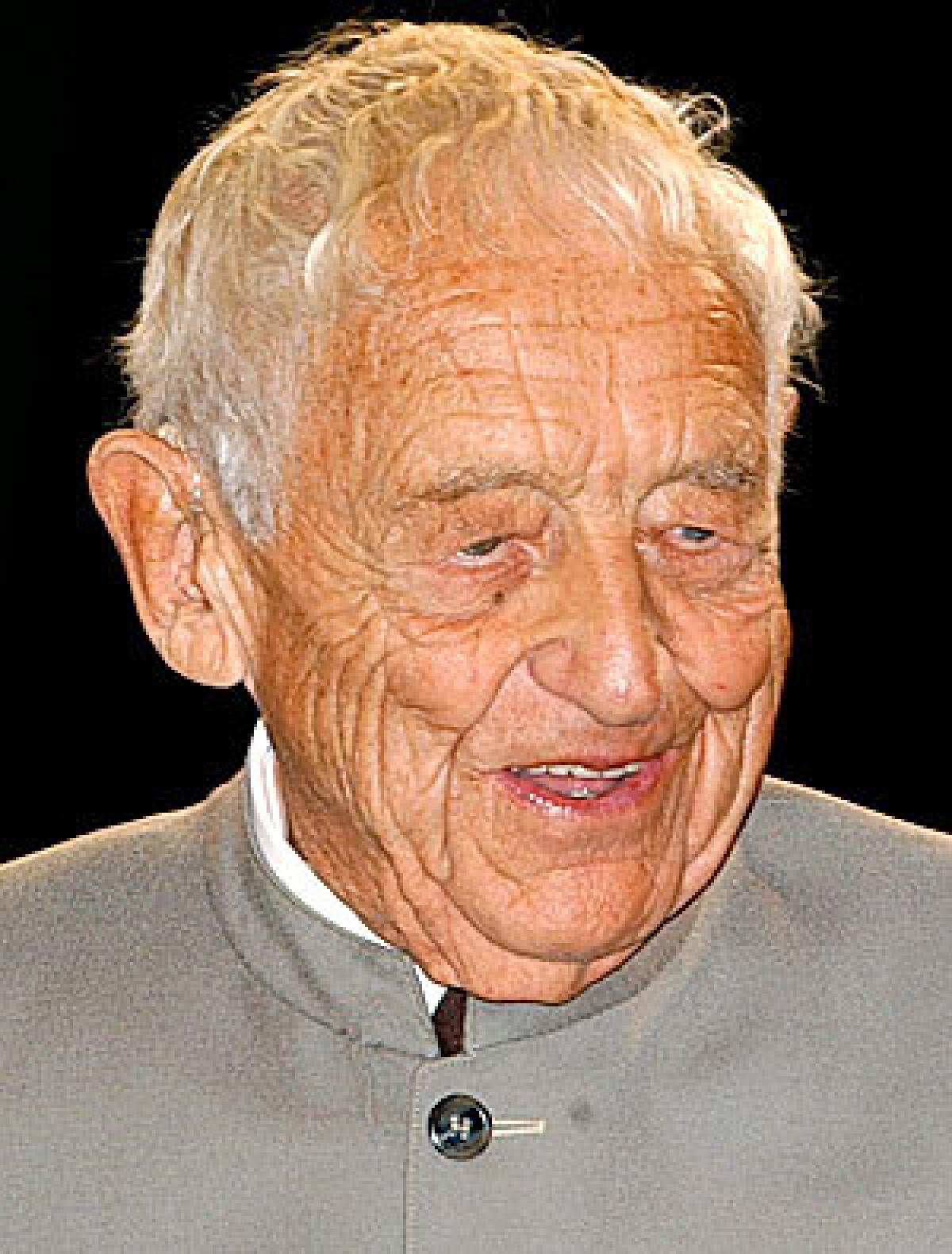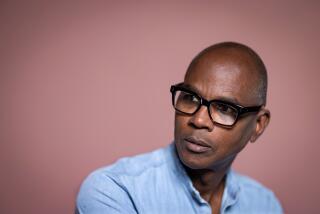Hugely popular painter Andrew Wyeth dies at 91

Andrew Wyeth, whose realistic yet often melancholy paintings of rural Pennsylvania and Maine made him one of America’s most popular living artists, and whose 1948 landscape “Christina’s World” was one of the 20th century’s most famous artworks, died Friday. He was 91.
Wyeth died in his sleep at his home in Chadds Ford, Pa., southwest of Philadelphia, after a brief illness, the Brandywine River Museum said in a statement.
By 1950, he was being called a “master of the magic-realist technique” and lauded as one of the greatest American artists. Life magazine declared him “America’s preeminent artist” in 1965, but an art world that increasingly embraced abstractionism seemed to take it as an insult.
When one art historian in 1977 was asked to name the most overrated and underrated artist of the century, he nominated Wyeth in both categories. Critics frequently disparaged Wyeth’s watercolor and tempera landscapes and portraits as “painting with a camera” and said he was merely a Norman Rockwell wannabe, but Wyeth -- like Rockwell -- was popular with Middle America and inhabitants of the White House.
His works connected with the public because they expressed post-World War II optimism combined with the anxiety and disconnection people felt in the mid-20th century, David Brigham, museum director of the Pennsylvania Academy of Fine Arts, told Reuters news service.
Jim Duff, director of Chadds Ford’s Brandywine River Museum, which houses many Wyeth paintings, called the artist “a man of extraordinary perception.”
“He highly valued the natural world, the historical objects of this world as they exist in the present, and strong-willed people,” Duff said in an Associated Press interview.
After “Christina’s World” was hung in 1948 in the Museum of Modern Art, it quickly became one of the New York City institution’s most popular works. In it, dark-haired Christina Olson, a Maine neighbor who was crippled from the waist down, tries to drag herself through tawny grass toward a weathered farmhouse. The technical virtuosity of the painting and the haunting loneliness that the scene evokes proved to be hallmarks of Wyeth’s style.
The public appeared to focus less on the painting’s dark elements and more on the way Wyeth had painted each blade of grass -- realism that went against the abstract art movement that was gaining in America in the late 1940s.
Only Grant Wood in “American Gothic” and Edward Hopper in “Nighthawks” have created works of comparable stature, Smithsonian Magazine decreed in 2006.
In 1986, Wyeth attracted a hint of scandal when he revealed that he had secretly painted his neighbor, Helga Testorf, for 15 years. He insisted that not even his wife, Betsy, had previously seen the more than 240 paintings and drawings, many of them nudes. The large number of works and the palpable charge that runs through them suggested more than a simple artist-and-model relationship.
The Helga chapter landed on the covers of Time and Newsweek as the public speculated over whether Wyeth, then 69, had had an affair with the woman 22 years his junior. As the Wyeths tried to explain the relationship, the art world wondered whether the secrecy and subsequent revelation had been staged simply to raise the popularity and price of the paintings.
“It was a love affair with the burning love that I’ve always had toward the things I paint,” Wyeth said of the Helga paintings. “If I don’t have it, the painting goes ordinary, routine.”
Leonard E.B. Andrews, a Pennsylvania publisher, bought the Helga collection in 1986 for a reported $6 million, and the National Gallery of Art in Washington, D.C., organized an exhibition of the pictures the next year. Andrews soon sold the Helga portfolio and other works to a Japanese collector for an estimated $45 million.
Stung by criticism over the “Helga hoopla,” Wyeth denied there had ever been a sexual relationship, and his wife admitted that not all of the works had been kept secret from her. When critics accused the Wyeths, and Andrews, of being “hucksters,” the artist verbally shrugged, saying critics “were just looking to bop me on the head.”
During the height of the controversy, then-Los Angeles Times art critic William Wilson called Wyeth “a votive image of American traditionalism. . . . At best, Wyeth is sensitive, neurotic and accurate. His existence as an American phenomenon cannot be discounted.”
Throughout his career of more than seven decades, Wyeth remained a figurative painter who prospered even when the genre was considered passe. He was tapped to paint a portrait of President Eisenhower for the cover of Time in 1959 and was given the nation’s highest civilian honor, the Presidential Medal of Freedom, by President Kennedy in 1963. Wyeth was a favorite of President Nixon, who hosted a dinner and exhibit for him at the White House in 1970 and toasted him as an artist whose painting “has caught the heart of America.”
On Friday, President Bush said Wyeth “captured America in his paintings.” The president also pointed out that he and his father, President George H.W. Bush, had recognized Wyeth’s contribution to American art and culture while in office.
Andrew Newell Wyeth was born July 12, 1917, in Chadds Ford, the youngest of five children of Newell Convers Wyeth and the former Carolyn Bockius. His father was also a noted artist, producing some 3,000 paintings and illustrating more than 110 books, including such classics as “Treasure Island” and “Kidnapped.”
One of Wyeth’s sisters, Henriette, became an artist of some note and married painter Peter Hurd. He introduced Andrew to egg tempera, pigments suspended in egg yolk rather than oil, a medium that Wyeth adopted early in his career.
A sickly child, Wyeth was educated at home by tutors. He learned to be a proficient draftsman before he could read and took up the aimless roaming about the countryside that would influence his art.
He grew up summering with his family in Maine and at 15 entered the studio of his father -- the only art teacher he ever had -- to begin rigorous academic training.
Wyeth had his New York City debut in 1937 and, in the depths of the Depression, all 23 watercolors had sold by the second day. His early work reflected the influence of landscape painter Winslow Homer.
Two years later, Wyeth met the strong-willed Betsy James, whose family also summered in Maine. They married in 1940, settled in Chadds Ford and had two sons, Nicholas, an art dealer, and Jamie, a well-regarded realist painter.
Wyeth’s wife became his protector and model, insisting that he cut back on commercial projects to focus on painting. She was also his business agent.
Betsy “made me into a painter that I would not have been otherwise,” Wyeth told his biographer, Richard Merryman. “She made me see what I wanted. . . . Betsy galvanized me at the time I needed it.”
Wyeth traced his birth as a serious artist to 1945 and the death of his father, whose car was struck by a train.
“When he died,” Wyeth said to his biographer, “I was just a clever watercolorist -- lots of swish and swash.”
His father’s death “gave me a reason to paint, an emotional reason,” Wyeth has said. “I think it made me.”
One of his better-known images is “Winter 1946,” a tempera that shows a boy racing down a hill near where Wyeth’s father died. “The boy was me at a loss, really,” Wyeth told his biographer. “His hand, drifting in the air, was my hand, groping, my free soul.”
Making landscape a subject in his work, Wyeth included people in such paintings so each helped reveal the other. He said he preferred “winter and fall, when you feel the bone structure in the landscape -- the loneliness of it. . . .”
“Faraway,” a 1952 painting, shows Wyeth’s then-young son Jamie sitting in a vast, empty field. The child wears a coonskin hat that suggests a vivid imagination but sits alone with his arms wrapped around his knees as if to protect himself.
Wyeth’s portraits of his Pennsylvania neighbors, farmer Kurt Kuerner and his wife, Anna, capture the bleak undertones of rural life. Another of Wyeth’s better-known paintings, “Ground Hog Day” (1959), shows the Kuerner dining room with its faded wallpaper and a table set for one. Outside the window, a split log with jagged edges points ominously at the house.
In the beginning, the practical and sociable Wyeth courted the public as potential customers. But as his fame and sales grew, he became something of a recluse.
Jamie Wyeth once compared his father’s work to that of poet Robert Frost, the Boston Globe reported. “At one level, it’s all snowy woods and stone walls. At another, it’s terrifying. He exists at both levels. He is a very odd painter,” his son said.
As Wyeth advanced toward artistic maturity, his work was in ever greater demand: His “Marsh Hawk” of 1964 was sold by Sotheby Park Bernet in 1981 for $420,000, then a record for a painting by a living American artist.
In 1976, he became the first living American artist to be given a major exhibition at the Metropolitan Museum of Art in New York City. He was also a top attraction at leading museums.
As he continued to make paintings that tell a story and capture the tattered remnants of pre-industrial America, Wyeth’s popularity warranted two major permanent exhibits of his art, housed in two separate museums.
In 1984, the Andrew Wyeth Gallery opened at the Brandywine River Museum. After exhibiting his work in solo and group shows for decades, the Farnsworth Art Museum in Rockland, Maine, opened its Wyeth Center in 1998 with a separate wing for Andrew Wyeth’s art.
Both museums feature art by three generations of Wyeths, including N.C. and Jamie.
Wyeth’s neighbors treated posing for Wyeth as a civic duty, not a money-making pastime, The Times reported in 2007. They had become accustomed to him wandering around their fields and farm buildings. When his attention was caught by a lace curtain blowing in the breeze or a piece of well-worn equipment, he began to paint.
“I like to be free,” Wyeth said in explaining his walks to his biographer. “Real emotions happen so rarely they are hard to come by. Not synthetic emotion, but emotion that tears your insides out. You want to be ready for it. I wish I could float over all this. And that’s, of course, the effect I’m after in my painting.”
Wyeth is survived by his wife, sons and a granddaughter.
Services will be private.
Oliver is a former Times staff writer.
Former Times staff writer Mary Rourke contributed to this report.
More to Read
Start your day right
Sign up for Essential California for the L.A. Times biggest news, features and recommendations in your inbox six days a week.
You may occasionally receive promotional content from the Los Angeles Times.







